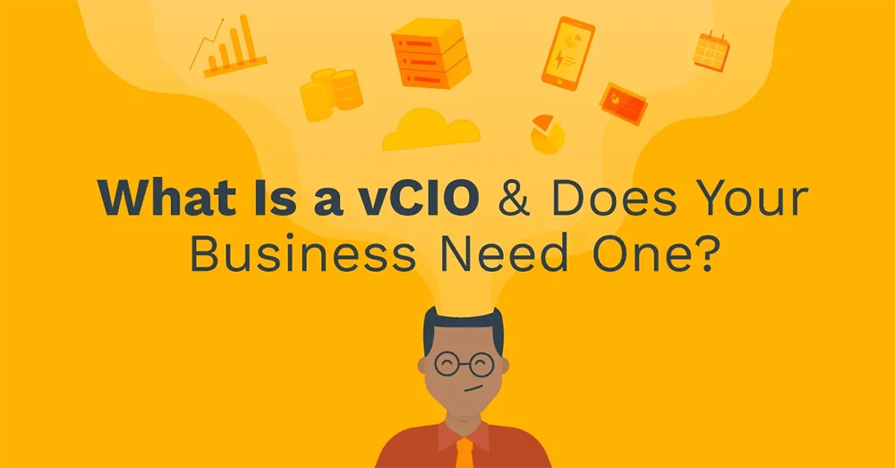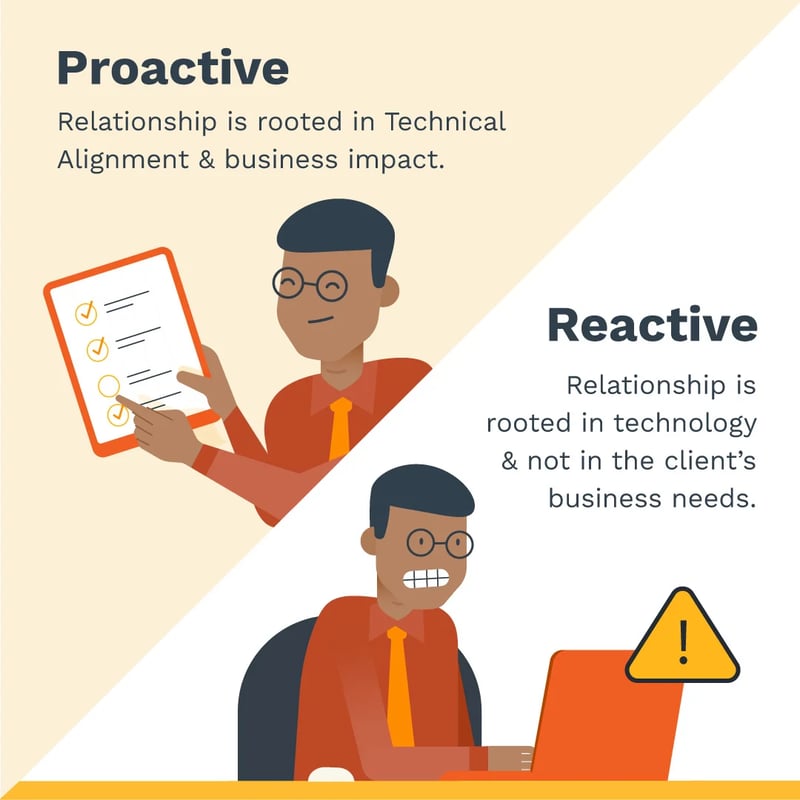As a small business owner or executive, you relish the challenges of punching above your weight. Your larger competitors have more resources to throw at the same challenges, and you can’t outspend them and survive. So you have to be more agile and strategic in your approach to those common problems.

The realm of IT is one area where this challenge appears. One solid solution that many small businesses have adopted is relying on a managed service provider for a significant portion of their IT needs. Doing so tends to save money and avoid some resource constraints.
One service associated with MSPs is the virtual chief information officer, or vCIO. What does this role entail, and does your business need one? Find answers below.
What Is a vCIO?
A virtual chief information officer (vCIO) provides the technology vision and strategy for your business needs and business goals in the same ways that an in-house CIO would. A vCIO nearly always works in conjunction with a managed service provider, or MSP.
In general, vCIO services are a significant value-add for small and medium businesses who have developed a robust IT strategy (or who need to do so), but who do not have the resources to hire a conventional CIO.
What Does a Virtual CIO Do?
What exactly a vCIO does will vary from one MSP to another, and it often varies from client to client within a given managed service provider. To understand why this is, let’s step back and examine the relationship between clients, their MSP, and their vCIO.
While the vast majority of small and medium businesses outsource some or even most of their IT needs to an MSP, nearly all SMBs maintain some form of in-house IT. How much a business offloads to an MSP varies greatly, and the interplay of MSP and in-house IT resources must be worked out on a case-by-case basis.
For the purposes of illustrating what a virtual chief information officer does, it’s helpful to think of your MSP as essentially one with your internal IT department. The MSP staff and your internal staff work together to execute initiatives and keep your IT infrastructure up to date and running well. This is true no matter what percentage of the work is outsourced and what percentage you retain in-house.
For companies that have the resources necessary to hire a full-time CIO, the relationship is pretty clear. The chief information officer sets the overall vision and IT strategy, and the “IT group” (made up of your in-house team and your MSP) get to work implementing that strategy.
For companies that don’t have those resources, setting an IT direction and vision can be a challenge. Your existing “IT group” puts out fires and maintains the status quo, and perhaps your small MSP (which doesn’t offer vCIO services) offers pointers from time to time. But it’s an incomplete solution.
A virtual CIO fills this gap. This person does much of the same vision-setting, strategic IT planning and budgeting as a full-time CIO would do — but as a part of the MSP’s payroll, not the company’s.
Why Does Your Small Business Need a vCIO?
Your small business needs more than just IT support. You need the right technology organized into the right IT infrastructure, governed in a way that meets all your IT needs.
Why does your small business need a vCIO? Chances are, you could use high-level guidance in at least these three areas: setting an IT vision, enhancing profitability through IT, and identifying and correctly implementing new technology.

Set an IT Vision
If you don’t have an in-house CIO, who is currently setting the IT vision? Is it you? Often, this task falls to the founder or CEO, who is often not equipped for the task.
Setting a vision for IT might also fall to the senior (or only) in-house IT person. But again, whatever this person’s job description says, their day-to-day is surely taken up with all sorts of crucial IT-related tasks. There’s no time to step back from it all and craft a cohesive direction.
Similarly, a small or up-and-coming MSP may offer “vision snippets,” little bits of direction here and there. But they face the same problem: they are too busy keeping your current it solutions running smoothly to take that crucial step back and evaluate.
This is where the vCIO can shine. Your vCIO isn’t burdened with a million day-to-day tasks. This person also has the deep background and industry experience necessary to set a vision and create a technology roadmap to execute that vision.
The vCIO should be able to answer questions and craft strategies around:
- Disaster recovery
- Employee on-boarding
- Cybersecurity and employee training
- IT strategy and development
- Cloud migrations
- System integrations
- Data and business intelligence
- Productivity optimization
Partnering with an established MSP that offers robust vCIO services can be the difference between just keeping up and making real progress in your IT landscape.
Another way a vCIO ensures the IT vision of the company is by taking a proactive approach through intensive technical reporting where strategies are examined on a predefined basis aligning technology and its impact to the business and its objectives. Truly becoming a business technology advisor.

Some areas that should be assessed are:
- Compliance needs and changes
- Risks
- Competition
- Competitive advantage
- Market alignment
- Current and future IT projects and the associated budgets/costs
- Support metrics and satisfaction
Enhance Profitability and Save Costs
We’re going to make a slightly obvious statement: adding C-suite positions is expensive. If you don’t have a CIO position now and are beginning to see the need for one, you’ll need to spend a significant amount to create the position. Then there’s the resource drain of finding a qualified candidate that’s a good fit for your business.
By partnering with an MSP that offers robust IT support, including vCIO services, you can gain this functionality for a lower and more predictable price.
Also, by bringing on a vCIO who will craft a vision and direction for your technology needs, your small business will see enhanced profitability—even through IT.
A vCIO can help to identify older or unused tools and subscriptions and can help to identify duplication of functionality. In setting a vision and identifying inefficiencies in your current IT setup, your vCIO can streamline your tools and reduce costs in the process.
Identify and Implement New Technology
Another significant way a vCIO can help your small business is through identifying and implementing new technology solutions while staying ahead of industry trends.
Think about your business as it is today. How do new technology ideas surface? Do you as an executive spend a portion of your time looking for new tools that could help you work more efficiently? Do you have a few employees who occasionally submit ideas? And is there a process in place for them to do so?
Whatever way the ideas come in (assuming they do), who vets them? Who makes the decisions about how and whether to implement a given solution into the rest of your IT infrastructure? If you have an in-house IT staff, are they really qualified to do this kind of troubleshooting and strategic thinking? In most cases, the answer is no.
A vCIO makes it their business to stay current on new technology and software solutions hitting the market in relevant industries. Someone in this role can vet these new products as they are released, deciding which would enhance your operations and which would merely replace existing functionality (or, worse, create distractions and inefficiencies).
With a vCIO in place, you’ll transform your business from a haphazard, slipshod approach to IT tools and solutions to a truly strategic approach.
How to Find a vCIO for Your Business
As a small business owner or executive, you’re passionate about business strategy and about having the right new technology in place to meet business needs. All of this is in service of maximizing both reach and profitability. For many small businesses, bringing in a vCIO is one deeply strategic move to help formulate and execute a forward-thinking vision for IT and IT strategy.
But how should you go about finding one? What should you look for, and what should you avoid?
First, as we mentioned before, not every MSP means the same thing when they use the term vCIO. The general concept is the same, but the specifics can vary. Firms like ours mean what we’ve described above— someone who can bring strategy and vision to your IT ecosystem. But less experienced firms may mean something less.
You want to watch out for smaller or less experienced MSPs that are claiming to offer vCIO service because it’s the trendy thing to do. In those situations, your “vCIO” may in reality be a glorified senior technician. A vCIO that doesn’t have any real strategy experience isn’t going to help your business to the degree that you want.
Instead, look to companies with proven track records of delivering value over the long haul. You want a managed services provider with a it team that has a deep bench, one that has the experienced resources in place to meet your every IT need — including true leadership and vision in their vCIO personnel.
Categories: Managed Services, Strategy, Managed IT Services, IT Management, VCIO











